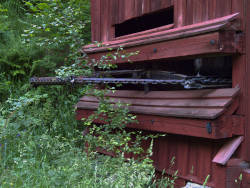Bastnäsfältet
Useful Information
| Location: |
Riddarhyttan.
Off RV 68 between Riddarhyttan and Fagersta. (59.846863, 15.589132) |
| Open: |
no restrictions. [2022] |
| Fee: |
free. [2022] |
| Classification: |
 Iron Mine Iron Mine
|
| Light: | bring torch |
| Dimension: | L=137 m. |
| Guided tours: | self guided |
| Photography: | allowed |
| Accessibility: | no |
| Bibliography: | |
| Address: |
Reservation, Tel: +46-222-133-30.
Turistbyrå Skinnskatteberg, Tel: +46-222-45045. Stiftelsen Ekomuseum Bergslagen, Nils Nils gata 7, 771 53 Ludvika, Cell: +46-70-376-74-25. E-mail: |
| As far as we know this information was accurate when it was published (see years in brackets), but may have changed since then. Please check rates and details directly with the companies in question if you need more recent info. |
|
History
| 1692 | first written mention of the mines at Riddarhyttan. |
| 1751 | report by mineralogist Axel Fredrik Cronstedt. |
| 1781 | Carl Scheele analyzes the tungsten, but finds nothing new. |
| 1801 | asteroid Ceres discovered by Giuseppi Piazza. |
| 1803 | Vilhelm Hisinger and Jöns Jakob Berzelius discover cerium and lanthanum. |
| 1875-88 | some 4,500 tonnes of high-value cerium ore mined. |
| 1979 | last mine closed. |
Geology
Bastnäs is the locus typicus (type locale) of bastnäsite, a cerium bearing mineral. The mine is located in a relatively small iron-ore field and not very important as an iron mine. But the iron contains other rare elements, namely cerium, and as a result there is an abundance of rare minerals found at the mine. 56 different minerals are known from the mine, the most interesting are bastnäsite, cerit, lanthanit, ortit, törnebohmi and linnéit.
Description


The Bastnäs gruvfält or Bastnäsfältet (Bastnäs mining area) is a small region with iron deposits and numerous abandoned mines. Beneath the mines, which are mostly waterfilled and none is accessible, there are several historic buildings from the times when the mines operated. The site is managed by the Ekomuseum Bergslagen and may be visited on self-guided tours, it is also possible to book a guide at the museum for groups.
Beneath the mine itself and the slag heaps with the abundance of minerals, the site also has a piece of mining industry history. Since 1873 a draught engine and a system of hooks was used to lift the iron ore from the mine. This technology was invented by Christopher Polhem. Power was transmitted mechanically from the Haggruvan mine to a windlass. This mechanism was located in a small building which is well-preserved and exists until today. A similar machinery at the Ludvika mining museum was removed from its original location at Grängesberg mine.
The chemical elements were mostly discovered during the 19th century. Two of them, cerium and lanthanum, were discovered in so called Bastnäs tungsten. The story of ceria started in 1751 with the report of mineralogist Axel Fredrik Cronstedt about the "heavy stone of Bastnäs". In Swedish this rock was called tungsten, tung sten meaning simply heavy rock in Swedish. A first chemical analysis of the rock was done by Carl Scheele in 1781. Vilhelm Hisinger (*1766-✝1852), a member of the family who owned the mine, sent him 15 samples of tungsten. But he did not find anything special.
Vilhelm Hisinger later became ironmaster and owner of the Skinnskatteberg works. He repeated the examination in 1803 together with the chemist Jöns Jakob Berzelius (*1779-✝1848). They discovered the element cerium and the element lanthanum. They isolated an earth similar to yttria but recognized it was distinct. The new element was named ceria in honour of Ceres, the first asteroid discovered only two years before by Giuseppi Piazza. Both names are derived from the Roman goddess of agriculture, Ceres.
But the story has a strange twist, which was typical for this time of discoveries. The discoverer is obviously the one who publishes his finding first. Hisinger and Berzelius sent their report Adolph Ferdinand Gehlen (*1775-✝1815) in Germany to be published in his Neues Allgemeines Journal der Chemie. But to make their priority certain, it was also printed in Swedish as a small pamphlet issued in only 50 copies, today an extreme rarity. At the same time Martin Heinrich Klaproth (*1743-✝1817) also analyzed tungsten from Bastnäs. He named the new element ochroite and also presented his results to Gehlen’s Journal. Klaproth’s article appeared in the issue before that containing the article of Hisinger and Berzelius. This would normally mean he was the discoverer and could name the elements. Today we do not know at which time or in which order Gehlen received the papers for publication. In his letter to Hisinger in May 1804 Gehlen gives Berzelius and Hisinger the honor of having discovered a new metal. As a result their name has prevailed, although Klaproth suggested the more correct name Cererium. Today it is generally accepted that the discovery took place simultaneously and independently, and all three Hisinger, Berzelius and Klaproth are usually named as co-discovers of Cerium.
As this story may show, this place is of great historic importance. At the same time it is of great importance for mineral collectors and mineralogists from all over the world. Samples from here are found in many collections worldwide. And the mine was of great importance during the last World War. Cerium was needed for military purposes and was extracted from the slag heaps of the mine.
- See also
 Search DuckDuckGo for "Bastnäsfältet"
Search DuckDuckGo for "Bastnäsfältet" Google Earth Placemark
Google Earth Placemark Bastnäs - Wikipedia (visited: 01-MAY-2022)
Bastnäs - Wikipedia (visited: 01-MAY-2022) Bastnäs gruvfält
Bastnäs gruvfält  (visited: 01-MAY-2022)
(visited: 01-MAY-2022) Bastnäs mines, Riddarhyttan, Skinnskatteberg, Västmanland - mindat.org (visited: 01-MAY-2022)
Bastnäs mines, Riddarhyttan, Skinnskatteberg, Västmanland - mindat.org (visited: 01-MAY-2022) Bastnäsite-(Ce) - mindat.org (visited: 01-MAY-2022)
Bastnäsite-(Ce) - mindat.org (visited: 01-MAY-2022) The old Bastnäs mine adit (visited: 01-MAY-2022)
The old Bastnäs mine adit (visited: 01-MAY-2022)
 Index
Index Topics
Topics Hierarchical
Hierarchical Countries
Countries Maps
Maps